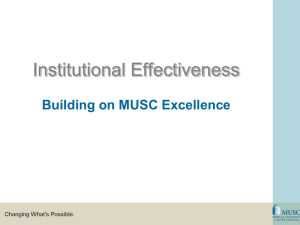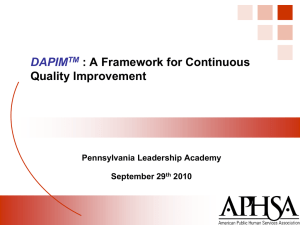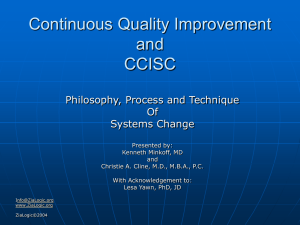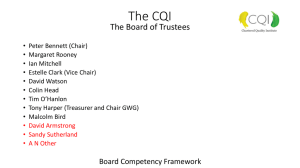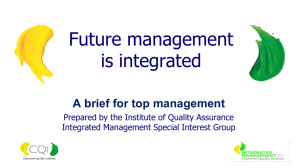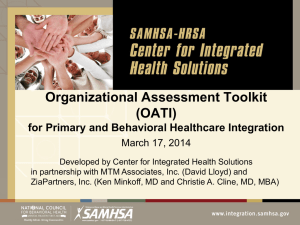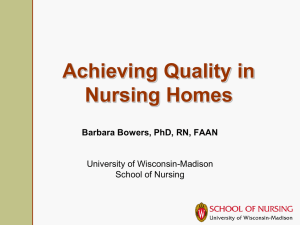Seizing the CQI Opportunity
advertisement
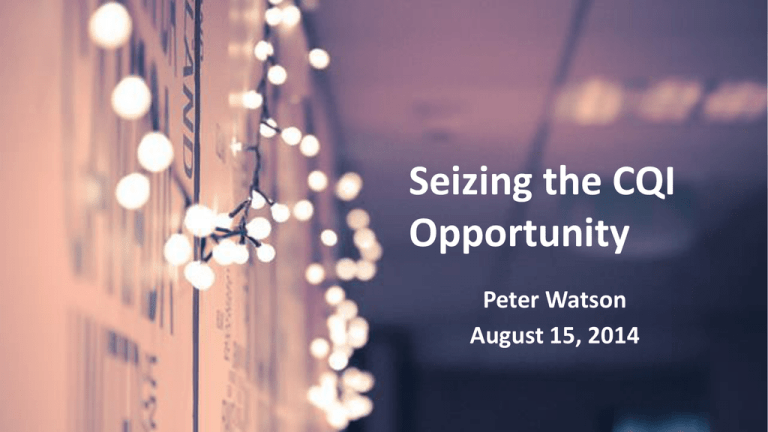
Seizing the CQI Opportunity Peter Watson August 15, 2014 CQI Framework and Definition • NRCOI/Casey CQI Framework (2005) • Developed by broad range of stakeholders • Presented CQI definition • Key CQI components • Cited in Children’s Bureau Information Memorandum on CQI, August, 2012 2 One Definition of CQI CQI is the complete process of identifying, describing and analyzing strengths and problems and then testing, implementing, learning from and revising solutions… 3 One Definition of CQI (cont.) It relies on an organizational culture that is proactive and supports continuous learning. CQI is firmly grounded in the overall mission, vision and values of the agency… 4 One Definition of CQI (cont.) Perhaps most importantly, it is dependent upon the active inclusion and participation of staff at all levels of the agency, children, youth, families and stakeholders throughout the process. 5 Visual from the NRCOI/Casey CQI Framework. Developed by working session participants. 6 Children’s Bureau CQI Components I. II. III. IV. V. Foundational Administrative Structure Quality Data Collection Case Record Review Data and Process Analysis and Dissemination of Data Feedback to Stakeholders and Decisionmakers and Adjustment of Programs and Processes 7 What is driving CQI in child welfare? 8 Past Pressures to Implement CQI •Change focus from compliance to outcomes •CFSR process began in 2001 •Quantitative and qualitative data •PIPs focused on systemic changes •Lack of measureable progress in many states •Accreditation efforts in some states •Lawsuits/settlement agreements •Heightened accountability expectations 9 Recent Pressures to Implement CQI •Children’s Bureau Information Memorandum on CQI—August, 2012 •Program Instruction on Child and Family Services Plan (CFSP) •Child and Family Services Review (CFSR) Round 3 process and data measures •CFSR On-site Review Instrument 10 The Eureka Moment Turning Pressure into Opportunity • Some agencies have stepped back to assess and improve their CQI systems • Target resources to CQI to move agency into “learning/assessment” mode • Daily question: “What can we learn from this?” • Viewing CQI as an organizational shift may be LESS overwhelming than trying to implement a series of technical components 12 What are Agencies Doing? •CQI system assessments •Engaging more staff and stakeholders in CQI •Reconsidering case review approaches •Linking data from multiple sources •Building data analysis skills at all levels •Focusing on action planning •Participating in the National CQI Academy •Finalizing CFSPs submitted in June, 2014 13 What are Your Pressures? •What pressures are you experiencing to implement a CQI system? •How might the different pressures on your management team impact your work together? •May need to understand these more to make progress 14 Lessons learned from State CQI Assessments 15 NRCOI’s CQI Assessment Process • Child Welfare Matters issue has details • Thank you to MN, OK, NM, FL, WI, IN and VA! • Pre-work: interviews, surveys, review current system elements, identify meeting participants • Meeting elements, including voting • Post-meeting • Mirror CQI action planning and implementation 16 Lesson 1: Develop Clear CQI Vision • CQI is more than just a set of activities • What are we trying to achieve through CQI? • If CQI were working optimally, what would be different in your work, the work of others, the response of stakeholders? 17 Shared Vision for a Learning Organization •A genuine mission and sense of “WE” and what “WE” are trying to achieve. •The vision drives curiosity and information seeking. •The vision is independent of leadership changes. •What is your vision for CQI? 18 Evolutional Direction for a CQI/QA system 1. A focus on effort: Datasets and reports on # served, caseloads, # with goals, % doing ___; % compliance ____. 2. to a focus on outcome: Data that can be mined for information on children/cases achieving and not achieving a goal. Drives change toward results. 3. and ultimately to a focus on impact: Data that pairs what happens or is done in cases to the results achieved. Hodges, K. & Wotring, J. (2012). Outcomes management: Incorporating and sustaining processes critical to using outcome data to guide practice improvement. Journal of Behavioral Health Services & Research, 39 (2), 130-143. 19 Lesson 2: CQI Leadership • Engage agency leadership in CQI • Varied commitment level across states/counties • Strategies for engaging and managing up • Building relationships to gain influence • Leading up, down, and across the organization (critical for CQI staff) • Continuously looking for ways to show CQI value 20 Lesson 2: CQI Leadership (cont.) • What are the unexpected leadership challenges of CQI? • How can we help each other anticipate and address them as we go forward? 21 Lesson 3: Challenges with Case Reviews • CQI = case reviews in many agencies • Many states have invested significant CQI resources in case reviews • Strong CQI systems use data from many sources • Third round of CFSR and expectations for states going forward 22 Current State Case Review Processes (Red = CFSR based; Blue = QSR;; Yellow = Other WA ME MT ND VT OR MN ID NH SD MI WY NV PA IA NE NJ OH IL UT DC IN MD CO CA WV KS MO VA KY NC TN AZ OK NM AR SC MS TX AL GA LA FL AK HI 0 0 AK & HI not to scale MA CT RI NY WI 500 Miles 500 KM DE Variations in Case Review Processes •Frequency of reviews •Sample sizes and stratification •Interviews with case participants •Training and support for case reviewers •Use of staff and stakeholders as reviewers •Use of results •Link to broader CQI activities 24 Lesson 4: Turn Data Into “Information” • Create common understanding to spark discussions and inform action planning • Review data regularly and share broadly • Train CQI staff to prepare, present and facilitate the use of data • Working paper on this topic: http://www.nrcoi.org/rcpdfs/CQIdataintoinformation.pdf 25 Lesson 5: Support Action Planning • Move beyond just collecting and analyzing data • Set expectations AND support efforts to use data to adjust practices and systems • Actively engage stakeholders in action planning • Start with small, doable solutions rather than grand solutions • Follow up and adjust! • Model action planning during CQI assessments 26 Lesson 6: Implementing CQI is a Challenge! • Difficulty of implementing CQI Action Plans • Confront idea that CQI conflicts with other priorities • Build relationships (up, down, and across the organization) to strengthen credibility • Prepare to be in “learning” mode throughout implementation to lessen frustrations when change is continuously required…flexibility is an absolute must! 27 Eureka! 28 CQI Should Help Promote Insight • CQI not just a technical approach • Create an environment where staff and stakeholders can make connections and try new approaches • “The Eureka Hunt,” by Jonah Lehrer The New Yorker, July 28, 2008. 29 Please Contact Me With Questions and Ideas Peter Watson Director, National Child Welfare Resource Center for Organizational Improvement pwatson@usm.maine.edu 207-228-8330 (o) 207-632-0892 (m) 30
